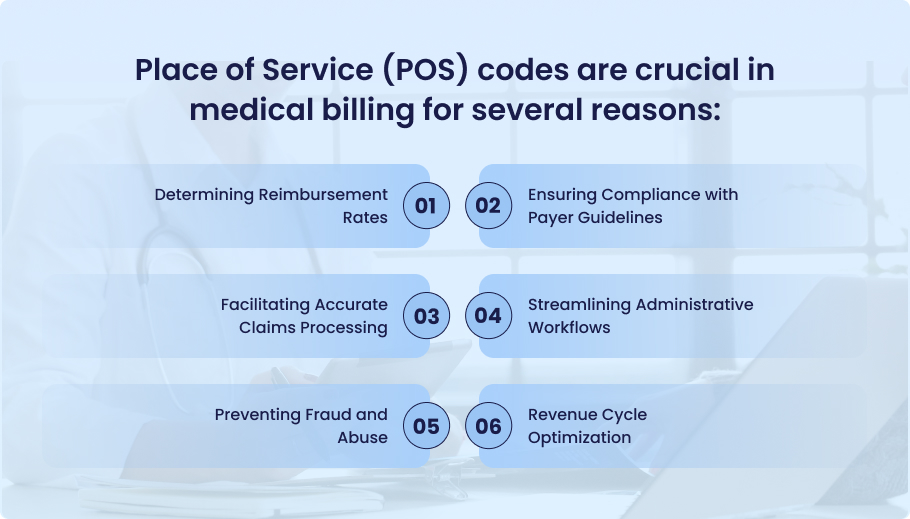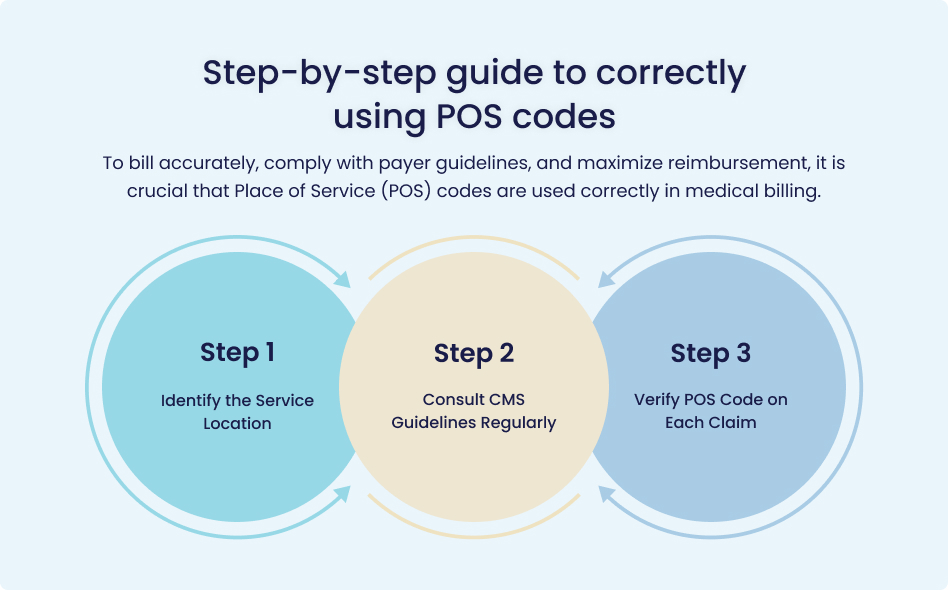
When it comes to medical billing, precision is key, and a minor error can have major financial ramifications. Among all the important aspects, one important yet overlooked entity is the Place of Service (POS) codes. These two-digit codes determine the exact geographical area of where the service is rendered. These codes are used to identify the specific location where a service is offered, impacting reimbursement rates and compliance with payer guidelines. Proper knowledge and application of POS codes are pivotal to avoid claim denials, cut-down the payment delay, and help your practice get better compensated as well.
In this blog, we will discuss POS codes—their types—along with some best practices in using them properly for a faster billing process to help your revenue cycle engine work more efficiently.
In medical billing, Place of Service (POS) is the geographic location or environment where the services were delivered to the patient. These locations are represented on healthcare claims by specific two-digit numeric POS codes assigned by the Centers for Medicare & Medicaid Services (CMS). These codes are critical in the evaluation of the correct rate of reimbursement as well as maintaining the compliance of the payer.
For instance, if the doctor treats a client in their office, then the service would be charged under POS code 11, which represents an office environment. If the same service were provided in a hospital’s outpatient department, the POS code would be different, like 22 for an on-campus outpatient hospital.
Application of correct POS codes is pivotal for ideal claim reimbursements because it reduces the chances of delay, denial, or even warranting an audit.
POS, or place of service, codes are two-digit numeric codes employed in medical billing to identify the precise area where services have been rendered by physicians to a patient. These codes are standard and have been set down by the centers for Medicare and Medicare Service; these have an important role to play when it comes to billing and processing for claims.
Each POS code refers to a distinct type of service setting, ranging from a doctor’s practice to a hospital, an outpatient clinic, or a patient’s residence. These codes help in establishing the area of service since its rates could vary differently from another area, and billing could also be different.
Determining Reimbursement Rates
POS codes help establish the correct fee schedule for services rendered. The setting—whether a hospital or a private office—affects the cost and, consequently, the reimbursement rate. For example, procedures conducted in a hospital generally incur higher costs than those in a private office.
Ensuring Compliance with Payer Guidelines
Proper POS coding is essential for meeting the billing requirements set by Medicare, Medicaid, and private insurers. Incorrect POS codes can lead to claim denials, delays, and potential audits, affecting the financial health of your practice.
Facilitating Accurate Claims Processing
POS codes ensure that claims are processed accurately by reflecting the true location of service delivery. This reduces discrepancies between provider billing and payer expectations, minimizing the risk of claim denials or underpayment.
Streamlining Administrative Workflows
Appropriate development and application of POS codes help to reduce such organizational operations within a medical practice. Implementation of POS codes makes it easier not to follow up on claims, minimizes communication with payers, and shortens the billing cycle.
Preventing Fraud and Abuse
POS codes also help to prevent fraudulent billing practices. POS codes that give accurate reports of where services have been provided make sure that the claims are valid and there is no misrepresentation of location by the providers to claim more reimbursements.
Revenue Cycle Optimization
Healthcare providers can increase their revenue cycle through proper application of POS codes. Correct coding results in fewer rejected claims, faster payments, and improved cash flow thereby enhancing the financial health of a practice.
Do You Know?
According to a survey conducted by the Healthcare Financial Management Association (HFMA), nearly 20% of denied claims in outpatient settings are attributed to errors in POS coding.
POS codes are classified according to the type of facility where patients receive their health care services. Here’s a breakdown of the major types:
Facility POS Codes
These apply for services given in recognized medical institutions like hospitals or surgical centers.
- POS 21 – Inpatient Hospital: For patients who receive inpatient services.
- POS 22 – On-Campus Outpatient Hospital: The outpatient department of a hospital located within its main campus.
- POS 23 – Emergency Room – Hospital: It is used when a service is rendered at an emergency department located at a hospital.
- POS 24 – Ambulatory Surgical Center: When surgery is performed at an outpatient surgical facility.
- POS 20 – Urgent Care Facility: This code is for care done at an urgent care center.
- POS 31 – Skilled Nursing Facility: When services occur at such facilities.
Non-Facility POS Codes
These codes are used for services provided outside of a formal medical facility.
- POS 11 – Office: For services provided in a physician’s office.
- POS 12 – Home: For services provided in the patient’s home.
- POS 03 – School: Used for services provided in a school setting.
- POS 49 – Independent Clinic: For services rendered in an independent clinic that is not part of a hospital.
Telehealth POS Codes
As telemedicine becomes more common, specific codes have been designated for services delivered remotely.
- POS 02 – Telehealth: For services provided through telecommunication systems where the patient is located in a different place from the provider.
- POS 18 – Store and Forward Telemedicine Services: For services where data is sent electronically and reviewed at a later time.
| Category | POS Code | Description |
| Facility POS Codes | POS 21 | Inpatient Hospital: For patients who receive inpatient services. |
| POS 22 | On-Campus Outpatient Hospital: The outpatient department of a hospital located within its main campus. | |
| POS 23 | Emergency Room – Hospital: For services rendered at an emergency department located at a hospital. | |
| POS 24 | Ambulatory Surgical Center: When surgery is performed at an outpatient surgical facility. | |
| POS 20 | Urgent Care Facility: For care provided at an urgent care center. | |
| POS 31 | Skilled Nursing Facility: For services provided at a skilled nursing facility. | |
| Non-Facility POS Codes | POS 11 | Office: For services provided in a physician’s office. |
| POS 12 | Home: For services provided in the patient’s home. | |
| POS 03 | School: For services provided in a school setting. | |
| POS 49 | Independent Clinic: For services rendered in an independent clinic that is not part of a hospital. |
|
| Telehealth POS Codes | POS 02 | Telehealth: For services provided through telecommunication systems where the patient is in a different location. |
| POS 18 | Store and Forward Telemedicine Services: For services where data is sent electronically and reviewed later. |
Do You Know?
According to the Medical Group Management Association (MGMA), practices receiving consistently coded POS errors have their reimbursement rates reduced by 15% to 20%. This may add up rapidly over time and can lead to a possible revenue loss of several thousand dollars each year. Moreover, correcting these errors is costly. According to HFMA, providers spend between $25 and $30 per denied claim to rework and resubmit them.
To bill accurately, comply with payer guidelines, and maximize reimbursement, it is crucial that Place of Service (POS) codes are used correctly in medical billing. Here is a step-by-step guide to correctly using POS codes:
Identify the Service Location
The first thing to do while using POS codes properly is to know where exactly the service was given. Be it in an office, a hospital, the home of the patient, or through telehealth, this identification is key.
Example: If you see a patient at their physician’s office, the appropriate POS code would be POS 11. On the other hand, if these services were offered in an outpatient hospital setting, then POS 22 should be used.
Consult CMS Guidelines Regularly
Medicare & Medicaid Services’ Centers for Medicare provide extensive guidance on POS codes. You need to take time off frequently to keep up with any changes that could be made and also new codes added.
Example: The CMS can change its coding system for different health care activities, such as location of care or telemedicine, and one must know when this happens.
Verify POS Code on Each Claim
Double check your claim before you send it to verify that your claim has the same code which reflects where you rendered your service from.
Example: Though care was provided to a patient in a skilled nursing facility, the latter does not qualify as an inpatient stay in a hospital.
Final Thoughts
Correct usage of Place of Service (POS) codes is vital for appropriate payment, minimizing claim rejections, and adhering to payer guidelines. Given the complexities and frequent updates in coding standards, consider partnering with a specialized medical billing service like MedHeave. Our expert team stays current with industry standards, ensuring accurate and efficient claims processing, faster payments, and reduced denials.
Focus on providing exceptional patient care while we handle the intricacies of billing.












